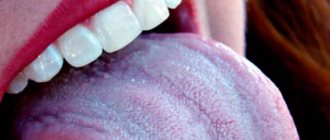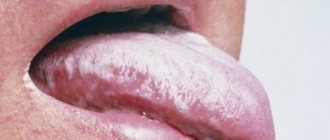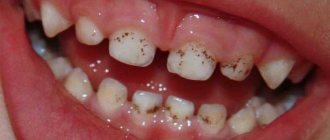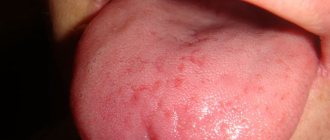When examined at a medical center, the patient is often asked to show his tongue as an indicator of health. By its appearance, a doctor of the highest category will be able to tell which organ system requires a detailed examination. Normally, the tongue is pink-red with a uniform surface and sometimes turns an unusual color - black, which can scare anyone. But today we will talk about whether such changes are always a sign of pathology, and also dwell on the causes of a rare symptom, methods of elimination, and prevention.
Should I worry?
When conducting an initial diagnosis, the doctor will pay attention to the thickness of the plaque, color intensity and other features. The most important sign of a specific pathology is the localization of layers on different parts of the tongue:
- Damage to the tip
indicates problems with the heart and blood vessels. - Coloration going deep into the organ
indicates breathing pathologies. - Spots on the central part
towards the root indicate diseases of the digestive canal. - On the sides
- about dysfunction of the spleen and liver.
The coating also varies in consistency. It can be greasy, curdled, wet or dry. In terms of area of distribution, it sometimes looks like clear spots, small inclusions, or completely covers the tongue. It is also important how the plaque is removed:
- Painless, but difficult.
- In the form of film.
- It is difficult and accompanied by severe pain.
Black deposits also appear against the background of other symptoms, such as:
- Nausea, vomiting.
- Thirst.
- Bad breath.
- Pain in different parts of the body.
- Fever.
- Yellowness, pallor or bluishness of the skin.
- Losing weight.
- Diarrhea or constipation.
- Heartburn, belching.
Such symptoms are only part of the overall picture. It will differ for a particular patient with a certain pathology. A black coating on the tongue can be a temporary phenomenon, caused by the influence of food pigments, both chemical and natural. There are many of the latter in blueberries, black currants, and mulberries. In such cases, there is definitely no reason to worry.
A similar situation develops after taking liquid iron-containing drugs or activated carbon. Slight darkening of the surface of the tongue occurs in those who like sweets with dark dyes, coffee or tea. It is not difficult to eliminate such plaque; just rinse your mouth several times or exclude the corresponding foods from your diet. It’s another matter when the nature of the symptom is related to the source of the pathological property.
Treatment
If a black coating is detected on the tongue, treatment must be based on an accurate diagnosis. Only in this case can you completely get rid of the disease, otherwise you can struggle with external manifestations for a long time and in vain, without affecting the very cause of darkening of the tongue.
Patients are usually interested in why a black coating appears on the tongue and what to do in this case. Only a doctor can answer the first question, since there are quite a few reasons for darkening of the tongue. The second answer should also be answered by a doctor, since the method of getting rid of black plaque directly depends on the diagnosis that will be established as a result of a thorough examination.
Be that as it may, at the first signs of the appearance of a dark coating on the tongue, all hygiene procedures should be carefully carried out, carefully cleaning the surface of the tongue with a toothbrush and paste.
Causes of black plaque
Factors that cause plaque in adults are associated with the following conditions:
- Acute tonsillitis (tonsillitis) and other infectious diseases.
- Long-term use of antibacterial agents, as a result of which the immune system weakens and dysbacteriosis develops.
- Slagging of the body.
- Excess weight.
- Violation of metabolic processes.
- Abuse of fatty foods and high-carbohydrate foods.
Crohn's disease is a rare autoimmune pathology. The melanin pigment is concentrated in the form of dark blue spots on the skin, tongue papillae and other mucous tissues. The condition occurs when the basic function of the adrenal glands is suppressed, and the organs of the digestive canal become inflamed. Treatment is carried out using hormonal and antibacterial agents, as well as immunosuppressants. The color of the tongue is restored as you recover. The plaque cannot be washed off by any other means.
Reasons for appearance
There may be quite a few reasons why a patient has a black coating on his tongue. Let's consider the most likely of them:
- acidosis (disturbance of the acid-base balance in the human body);
- diseases of the pancreas, gall bladder and digestive organs;
- presence of cholera infection;
- development of acute infectious diseases;
- the appearance and reproduction of chromogenic fungus in the oral cavity.
Let's look at all these reasons in more detail.
Angina
A black coating on the tongue in the morning may indicate a sore throat, especially if the patient has a very high fever and there is an acute respiratory viral infection in the body. In this case, you need to consult a doctor so that he can establish the correct diagnosis and prescribe adequate treatment. If you have a sore throat, a black coating on the tongue does not require any separate treatment; after recovery, it will disappear on its own. During illness, oral hygiene procedures should be carried out very carefully, cleaning not only the teeth and gums, but also the tongue.
Acidosis
As a result of a change in the acid-base balance towards increasing acidity, the patient's tongue may have a black or dark coating. Only an experienced doctor can make a diagnosis based on clinical studies and tests. Therefore, if you are concerned about a dark coating on your tongue, you should consult a general practitioner, undergo an examination, and only then begin treatment.
Diseases of the digestive tract
If you have a black coating on your tongue, the reasons may be the development of diseases of the gastrointestinal tract, primarily the pancreas and gall bladder. Many patients complain that along with the plaque there is a bitterness in the mouth, although they have no problems with the stomach. In fact, the disease can occur in a latent form, without showing itself for the time being. At the first signs, you should consult a doctor and take a blood test to rule out the presence of serious pathologies of the gastrointestinal tract.
Antibiotics
A black coating on the tongue after antibiotics appears quite rarely and usually signals a weakened human immune system. After all, antibiotics are not taken on their own; they are prescribed only for serious indications. And, accordingly, such a patient’s immunity is weakened. Taking antibiotics is also associated with the risk of multiplying a fungal infection, and the development of chromogenic fungus in the oral cavity only increases the risk of black plaque formation.
In the morning
Dark plaque on the tongue and teeth in the morning is a fairly common phenomenon, since bacteria and microorganisms actively multiplied in the patient’s mouth overnight. It is extremely important to brush your teeth before going to bed, this way we reduce the number of pathogenic bacteria and prevent the appearance of dense plaque.
Thrush
Black coating on the tongue and thrush are not as closely related as they might seem. Most often, with thrush, a white coating appears, which is quite difficult to remove; soon it appears again and again. But if the disease is in an extremely advanced state, the coating on the tongue may darken and resemble black in color.
Bitterness in the mouth
A black coating on the tongue and bitterness in the mouth may indicate diseases of the pancreas and gall bladder. With these diseases, dehydration of the body often occurs, which is expressed in the appearance of bitterness in the mouth.
Sometimes patients ask why a black coating appears on the tongue if everything is fine with the digestive tract. We remind you that sometimes diseases occur in the so-called latent form, in which the patient is not even aware of the presence of the disease. And dark language should definitely alert you.
Chromogenic fungus
Black-green plaque may be the cause of chromogenic fungus in the oral cavity. In this case, plaque covers not only the patient’s tongue, but also his teeth and gums. Dark green spots appear on the surface of the tooth enamel. In this case, it is necessary to observe extremely careful oral hygiene.
How to treat black tongue
Complete elimination of a symptom depends on the source of its occurrence. This is what therapy is aimed at, including various methods, such as:
- Compliance with a special diet if the cause of plaque is gastrointestinal pathology.
- Medicines to combat inflammation, pathogenic bacteria and associated symptoms.
- Physiotherapy.
- Folk remedies.
- Surgical intervention in difficult situations when other treatment methods have proven ineffective.
Effective formulations include tinctures and decoctions for rinsing the mouth. They are based on the following medicinal plants;
- Linden;
- oregano;
- yarrow;
- chamomile;
- plantain;
- oak bark;
- mint;
- sage;
- strawberries;
- flax seeds.
Causes of dark plaque on the tongue
Thick deposits that cannot be cleaned off can indicate serious problems in the functioning of the body. The causes of deposits can be both internal and external. The latter include:
- Taking medications such as Faringosept, Malavit, steroids, drugs that contain bismuth.
- Deficiency of nicotinic acid or vitamins PP, group B.
- Black spots appear due to lead poisoning.
- Tobacco smoking, excessive indulgence in fatty foods, sweets, and alcohol.
- Dehydration or acidosis.
The reasons for the appearance of dark plaque lie in many diseases.
- Advanced oral candidiasis and stomatitis.
- Severe disturbance of the microflora of the oral cavity.
- Progressive diseases of the gastrointestinal tract in chronic form - gastritis, enterocolitis, dysbacteriosis, liver pathologies, cholecystitis, pancreatic diseases.
- Advanced infectious diseases - pneumonia, arthritis, blood diseases, tonsillitis, nephritis, cholera.
Child's black tongue
If you exclude markers, paints, and food, then most often the problem with a dark tongue in a child is associated with candidiasis (thrush). The reason is simple - the baby began to be fed ahead of schedule. A black tongue in an older child may be a sign of pathologies of the gallbladder, colitis, gastritis, and enteritis. A gray coloration on the tongue appears in a child if he is treated with iron-containing compounds.
It is difficult for parents to independently understand the etiology of the problem. Only passing the necessary tests and diagnostics will help the doctor find and eliminate the cause of the symptom. At the initial stage, this specialist becomes a pediatrician, then a dentist or an infectious disease specialist joins, depending on the diagnosis.
Plaque in children
In children, a brown coating on the tongue can indicate the same problems as in adults. First of all, an experienced doctor will determine the location of the greatest accumulation of plaque. If a thick layer is located on the tip of the tongue, then this most likely indicates problems with the lungs and bronchi. If plaque spots are located symmetrically on the tip of the tongue, then this may even be a sign of incipient double pneumonia. If a child has a predominantly brown coating located in the center of the tongue, then this most likely indicates problems with the gastrointestinal tract. Be that as it may, the child should be shown to an experienced pediatrician as soon as possible. Only he will be able to refer you for examination, establish the correct diagnosis and prescribe adequate treatment.
Prevention
Dark spots on the tongue will never bother you if you follow the following rules and recommendations:
- Minimize the consumption of spicy, fatty, carbonated water, coffee.
- Maintain good oral hygiene. In addition to teeth, clean the inside of your cheeks, gums, and tongue. Teach children to this. Use plant extracts for rinsing. Don't skimp on toothpaste.
- Get rid of bad habits: smoking and alcohol abuse.
- When treating with antibacterial compounds, strictly follow medical recommendations.
- Expand the amount of physical activity in accordance with age and health status.
- Add bran, fruits, and vegetables to the menu. Nutritious smoothies are beneficial. Instead of black tea, drink mint, strawberry, linden or other herbal tea.
- If you are prone to sore throat, try not to injure the mucous membrane of the throat, for which purpose eat dishes in the form of puree. Inhalation is carried out using sea buckthorn or fir oil.
- If a child’s tongue turns black, consult a pediatrician to find out what new food triggered such a symptom, so that you can then help the child adapt painlessly. Treatment methods for children do not differ from those for adults. Great care and smaller dosages will be required, as determined by your doctor.
- Baby food should be natural and consist of fresh products. On the recommendation and under the supervision of a pediatrician, vitamin and mineral complexes can be given to the child to strengthen the immune system.
Do not practice self-medication, which rarely ends well. If the condition worsens, immediately contact a doctor. Regularly visit an ENT doctor, dentist and other specialists for preventive purposes. Bitter salt for cleansing the intestines, you can find out at the link.
Treatment of dark plaque
Patients with dark deposits on the muscle organ are advised to systematically treat their teeth. This will help avoid unpleasant symptoms. Oral hygiene procedures are mandatory. You should clean not only your incisors and molars, but also your tongue twice a day. You can use a special scraper and gels. It is important not to injure mucous tissues. Treatment of acidosis begins with drinking plenty of fluids.
Of course, it is impossible to get rid of dark layers if the underlying disease is not treated. Therapy is prescribed individually based on the established diagnosis.
- For stomatitis, you should rinse your mouth with a liquid containing antiseptics such as Hepilor or Chlorophyllipt.
- Antifungal agents eliminate candidiasis. These are Clotrimazole, Pimafucin, Fluconazole.
- The microflora in the intestines is restored by probiotics with bifidobacteria and lactobacilli. Most often, Linox and Acipol are prescribed.
- Prebiotics stimulate the body's production of its own beneficial bacteria. The nutrient medium for them is created by Duphalac and Lactusan.
- The body's defenses are increased by Cycloferon, Kagocel, Ribomunil.
- The secretion of gastric juice is stimulated by Limontar and Etimizol, which is important for low acidity.
- Aggressive gastritis is treated with antibacterial drugs, in particular Cephalexin.
- Toxic substances are well removed by a sorbent such as Enterosgel.
If the patient complains of heartburn, he is prescribed Rennie, Maalox and other medications. The gastric mucosa is well protected by De-Nol and Venter. Deficiency of vitamins PP and group B is eliminated by taking vitamin complexes. Dietary nutrition is often prescribed. The program is developed for each patient individually.
Why does a mole appear on the tongue?
The main reason for the formation of a nevus is a genetic predisposition that is passed on from parents. Doctors conditionally divide all moles and birthmarks into congenital and acquired. The first ones are practically not dangerous in terms of oncology. They are formed in infancy and gain color saturation during puberty. The latter appear on the mucous membrane and tongue under the influence of various negative factors:
- a sharp hormonal surge;
- persistent burns from tanning or prolonged exposure to the sun;
- rubbing the area with the nevus with the edge of a tooth, denture or brush when cleaning;
- frequent tongue burns when drinking hot drinks;
- smoking;
- inflammatory and infectious processes in the oral cavity;
- chronic purulent tonsillitis.
The main question is: is a mole located on the mucous membrane of the mouth dangerous? If the nevus on the tongue does not bother you and does not cling to the sharp protrusions of the incisors, it does not need to be removed. Unfortunately, the oral cavity is constantly exposed to temperature changes when smoking and eating, and contains a large number of pathogenic bacteria that weaken local immunity. Therefore, moles in such a specific location require constant monitoring.
Periodically, the patient is recommended to conduct a self-examination. To do this, you only need a small mirror, which is installed next to the table lamp to ensure proper and complete illumination. First, the tongue is cleaned with a gauze swab and rinsed thoroughly with plain water. A person needs to make sure that the dark spot has not changed shape or color.
Benign neoplasms of the oral cavity
“Something” that appears in the mouth does not grow, does not appear in a new place and, in principle, does not hurt. This means that the tumor is benign in nature. They, in turn, are divided into several subspecies.
Epithelial growths: papillomas, nevi, Serre glands. Papilloma is a small protrusion with “papillary” growths; when left in the mouth for a long time, it becomes rough and whitish. A nevus that varies in color, ranging from pale pink to brown. If you notice a yellowish semicircle above the upper or lower gums, it is most likely a Serra gland.
There are many more types of connective tissue tumors. Fibroids of identical color form on the lower lip, tongue or palate. After inflammation of the gums, compactions can form - fibromatosis. Lumps on the muscle tissue on the underside of the tongue and underneath it are called fibroids.
In addition to connective tumors, neoplasms of the oral mucosa are vascular. More often they develop in children and appear after diseases of the nasopharynx.
Types of nevus on the tongue
Moles and birthmarks on the oral mucosa are extremely rare. A person can live for many years without noticing the smallest black dot on the surface of the tongue. Usually the dentist finds it during the next examination, or the tumor begins to itch unpleasantly. There are several types of nevus on the tongue, which are diagnosed more often than others:
- Papillomatous: in appearance, such moles resemble small warts. They are just as convex and round, and have a pink or light brown color. Appearing in childhood, they can grow due to a decline in immunity or chronic inflammation in adulthood.
- Vascular type: this nevus looks like a vessel protruding above the mucosa. It has a bluish or pink tint characteristic of the capillary. It rarely causes health problems, but it does not look very aesthetically pleasing. Due to its convex shape, it is easily damaged by the edges of the teeth.
- Blue type of moles: a separate group of formations. They often appear during periods of hormonal surge or imbalance (puberty, pregnancy, menopause). They take on any shade from pale blue to dark blue, and require constant monitoring by a doctor. This is one of the few species that degenerates into dangerous melanoma.
- Nevus Oto: an almost benign type of mole that resembles a scattering of dark spots and dots. If it appears on the tongue, it will gradually spread to the larynx, gums of the upper jaw and the inside of the cheek.
- Borderline: the most common type of moles, which grow throughout life in proportion to the person’s body. They have a flat shape, so they hardly interfere with chewing food and talking. The average size of a dark spot reaches 0.5–1 cm.
Very often, only a biopsy helps to correctly determine the type of nevus on the tongue. This is a special type of diagnosis for which it is necessary to take a piece of tissue from the surface of the mucosa. Biological material can be collected by a dentist during a routine examination or dental treatment.
Therapy
If a person develops dark brown spots on the tongue, it is important to consult a doctor and be examined for oncological pathology, since timely therapy in this case will solve the problem. Temporary stains, in particular those resulting from chemical exposure, can be eliminated through proper oral hygiene.
Oral hygiene involves carefully cleaning the deposits on the tongue with a soft brush. In addition, it is important to eat healthy whole foods, fruits, and vegetables.
Many pathologies accompanied by this symptom respond well to treatment with medications and vitamin complexes.
Treatment of the surface of the tongue can be carried out using effective resorption medications - “Imudon”, “Lizobakt”. You can also make oral baths based on decoctions of medicinal herbs (chamomile, sage) or antiseptic solutions of pharmaceutical origin (Miramistin, Chlorhexidine).
If spots on the tongue are caused by a fungal infection, the patient is prescribed bifidobacteria, lactobacilli, and probiotics to normalize the microflora. In addition, the use of antifungal drugs is indicated - Livarol, Fluconazole, Nystatin, Diflucan. Antiseptic solutions are used for local treatment of the oral cavity.
In some cases, experts recommend treating the mouth with liquid nitrogen. Such a procedure should be carried out exclusively in a medical facility and only under the supervision of a doctor. Self-treatment with nitrogen is unacceptable. It is worth noting that in the field of dentistry, this method of therapeutic effects has not found wide application.
In cases where conservative therapy in the form of medication does not bring the required result, experts recommend surgical intervention.
You can also remove such stains by sucking on a small piece of pineapple, then holding it on the root of your tongue for 40 seconds and chewing for 8 minutes. This should be done twice a day for 14 days.
Hyperpigmentation
Brown spots on the tongue of an adult may occur due to hyperpigmentation. This happens due to the high concentration of melanin in the body. It is this substance that colors hair, eyes, and skin. If a large amount of melanin accumulates in the tissues of the tongue, harmless dark spots begin to appear. Hyperpigmentation of the tongue is caused by melanocytes - pigment cells.
However, sometimes brown spots on the tip of the tongue, caused by hyperpigmentation, are evidence of the development of melanoma, a type of cancer. Typically, melanoma develops under exposure to UV rays from the sun. The risk group includes people over 40 years of age, in particular women. As a rule, melanomas are brown or black in color, however, they can also be purple, red, or pink.
A photo of a brown spot on the tongue is presented.
Traditional medicine involves removing pigmentation using a laser. In folk medicine, rosehip, aloe vera, cucumber, lemon, and potato juices are used to lighten darkened tongue and skin.
Melanin production is reduced by hydroquinone. It contains calcium, kojic and azelaic acids, cucumbers, soy milk.











